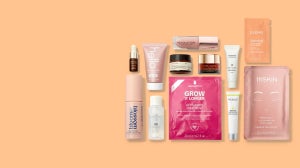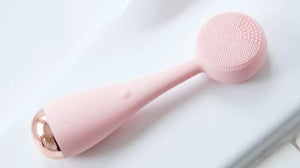
On the surface, face oils and serums look almost identical – it’s really no wonder they cause so much confusion. But look closer and you’ll find a stark difference between the two. Not just in their consistencies, but their ingredients and purpose too. Understanding how they work and when you should use them will help you find the formulas best suited for your skin’s needs.
That’s why we’ve put together the ultimate guide to face oils and face serums. You’ll learn the difference between the two, their , and how to use them in your skincare regimen. So read on for the answers to all your burning serum and face oils questions.
What Are Face Oils?
Facial oils are oil-based formulas that are designed to nourish, protect, and strengthen your skin. Usually rich in antioxidants, plant extracts, and essential oils, these emollients work by restoring your skin’s lipid barrier – that’s where your skin’s natural fats and ceramides live. Maintaining a strong skin barrier helps to lock in moisture, which in turn, keeps skin hydrated, plump, and healthy.
Some facial oils are pure – popular ones you might have heard of are rosehip oil, jojoba oil, and marula oil. Whereas others are enriched with active ingredients to help address your common skin concerns – think wrinkles, dullness, hyperpigmentation, and more. Face oils with vitamin C are perfect for brightening, while dry skin facial oils are formulated with super-hydrating ingredients like almond oil.
And they’re suitable for all skin types too. Yes, even oily and acne-prone skin! There’s a common misconception that people with these skin types shouldn’t use a facial oil, but use one that’s non-comedogenic (meaning one that doesn’t block pores) and it’ll help to balance oil production and even control breakouts.
Want to find the best face oil for your skin type? Read our Complete Guide to Facial Oils.
How Do You Apply Face Oils?
If you’ve got dry skin, you might be tempted to overload on facial oil. And if you have oily skin, you might not be using one at all. But a few drops of facial oil goes a long way to restoring your complexion.
You should apply facial oil as the last step in your routine because it acts as a barrier to protect your skin, while sealing in moisture from your other skincare products.
Start with cleansed, dry skin. Sweep some toner over your face and apply your favorite serum. If you have particularly dry skin, you may also want to apply a moisturizer.
Then disperse 2–5 drops of facial oil (depending on your skin type) into the palm of your hands. Rub your palms together and gently massage the oil into your face and neck.
Apply a facial oil daily and expect a radiant, lit-from-within glow and calmer, happier skin.
What Is Face Serum?
Face serums are lightweight liquids that are used after cleansing and before moisturizing. They deliver a concoction of active ingredients deep into your skin. These fast-absorbing formulas are specially designed to target one or multiple skin concerns, like dark circles, blemishes, and fine lines.
They’re usually concentrated, water-based formulas that easily penetrate your skin. In hydrating serums, you’ll find lightweight moisturizing ingredients like squalane or hyaluronic. These ingredients draw moisture into the skin for instant hydration and plumping. Or you can dial up your skin’s luminosity with a face serum with vitamin C. Serums can be used overnight too. Look for nighttime serums powered by exfoliating AHAs and wake up with smoother, more even skin.
With so many serums available, you can find one that’s tailored to your skin’s needs. But if you’re not sure which one to choose, read our blog post: Which is the best serum for my skin type?
How Do You Apply Face Serums?
Because of their lightweight texture, serums should be applied before your moisturizer, and after cleansing and toning. This helps them to sink deep into your skin.
Cleanse your skin and pat dry. Dampen a cotton pad with your favorite toner and sweep this across your face and neck.
Next, dispense a few drops of serum into the palm of your hands. The aim is to apply a thin layer covering your face and neck.
Gently pat this into your skin. Patting instead of massaging helps boost microcirculation, reducing puffiness, and brightening your complexion.
Follow with a moisturizer and/or facial oil.
Face Oil or Serum: Which One Should You Use?
As a reminder, face oils protect and strengthen your skin by restoring its barrier. And they give you an immediate, dewy glow. Facial serums, on the other hand, target specific skin concerns like wrinkles, hyperpigmentation, enlarged pores, uneven skin texture, and so on.
If you want to, face oils and serum can be layered. You might choose to do this if you have thirsty skin that craves the extra moisture. Or if you want to address one or more skin concerns. Using a serum and oil will ensure your skin is getting the protection and hydration it needs, all while addressing the specific concern too.
And, both products can be used morning and night too. Just remember that oils should always be applied last in your routine, as they can penetrate serums and moisturizers, but your other skincare products can’t penetrate facial oils.
So which formula you decide to use all depends on your skin goals and personal preference.








